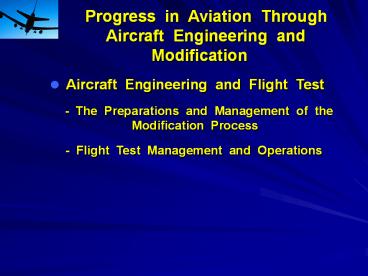Aircraft Engineering and Modification Aircraft Engineering - PowerPoint PPT Presentation
1 / 9
Title:
Aircraft Engineering and Modification Aircraft Engineering
Description:
Aircraft Engineering and Modification Aircraft Engineering and Flight Test - The Preparations and Management of the Modification Process - Flight Test ... – PowerPoint PPT presentation
Number of Views:463
Avg rating:3.0/5.0
Title: Aircraft Engineering and Modification Aircraft Engineering
1
Progress in Aviation Through
Aircraft
Engineering and Modification
- Aircraft Engineering and Flight Test
- - The Preparations and Management of
the Modification Process - - Flight Test Management and Operations
2
Progress in Aviation Through
Aircraft
Engineering and Modification
- The Preparations and Management of the
Modification Process - Each Aircraft Modification Will Vary
According To The Type Of Modification, Reason
For Modification And Aircraft Requirements - (1) Documentation For Modification
Procedures Can Only Be Completed - When The Purpose And Requirements
Are Understood. - (2) Familiarity Is Required With Existing
Structural And Systems - Characteristics So Compatibility
Problems Can Be Avoided. - (3) Each Modification Service Consults
With The Regional FAA Aircraft - Certification Office (ACO).
- (4) The Company Performing The
Modification Is Expected To Propose - An Overall Certification Plan.
3
Progress in Aviation Through
Aircraft
Engineering and Modification
- The Preparations and Management of the
Modification Process - Dependent On The Type Of Modification
Certain Documents Are Prepared - (1) A Supplemental Type Certificate (STC)
Is A Document Issued By - The FAA Approving A Product
Modification. - (a) The STC Defines The Change In
The Product Design - (b) States How The Modification
Affects The Existing Type Design - (c) Identifies The Serial
Effectivity - (2) If A Repair Is Completed, Which Is A
Type Of Modification FAA Form - 337 Must Be Completed.
- (3) An FAA Order 8110.3 Is A Statement Of
Compliance With The - Federal Aviation Regulations (FARs)
- (4) A Prepared Data Package Contains All
Drawings, Engineering - Reports And All Relevant
Information Explaining The Modification - Work Effort.
4
Progress in Aviation Through
Aircraft
Engineering and Modification
- The Preparations and Management of the
Modification Process - Each Company That Provides A Modification
Service Is Obliged To Employ The
Professionals With The Necessary Skill-Set
Requirements - (1) Some Certified Professionals Include
- (a) FAA DERs In Different Type Of
Specializations - (b) FAA Designated Manufacturing
Inspection Representative - (c) Avionics Modification
Installation Specialists - (d) Specialists With FCC
Radiotelephone And RADAR Endorsements - (e) Inspection Authorization
Personnel - (f) FAA Certified Airframe And
Power plant Technicians - (2) Identifying All Pertinent FARs Under
Parts 23 And 25 Affected By - The Modification Is Paramount For
Safety. - (3) To Quantify Safety Engineering Areas
Failure Modes And Effects - Analysis (FMEA) And Fault Tree
Analysis Are Used.
5
Progress in Aviation Through
Aircraft
Engineering and Modification
- Flight Test Management And Operations
- The Flight Test Management Process
And Operations Is Determined Before The
Completion Of The Modification - (1) Documentation Obtained During And
Sometimes Prior To The - Aircraft Modification Effort Include
- (a) Aircraft Airworthiness Document
- (b) Type Certificate
- (c) STCs
- (d) Other FAA Documentation
- (2) Dependent On The Kind Of Modification
The Flight Tests May Vary. - (3) Aircraft Preparation, Certification
And The Availability Of Qualified - Flight Engineers, Navigators And
Test Pilots Are Important Elements - In Determining Flight Test
Readiness.
6
Progress in Aviation Through
Aircraft Engineering and
Modification
- Aircraft Engineering Methodologies and
Project Installations - - The Empennage Strain Gage Survey
Equipment With Data Acquisition - - Traffic Collision Avoidance System
(TCAS II) - - Initial Reference System ( IRS )
7
Progress in Aviation Through
Aircraft Engineering and
Modification
- Empennage Strain Gage Survey Equipment With
Data Acquisition System - Specialty Measurements Incorporated (SMI)
Designed The Empennage Strain Gage Survey
Equipment. Validyne Engineering Corporation
Provided The Data Acquisition System - (1) Objective Of Installation - Measure
Flight Loads Imposed On Tail Of An - Executive / Commuter Aircraft Under
Real Flight Conditions. - (2) Thirty-Four Strain Gages Placed In The
Vertical And Horizontal Stabilizers - Are Chosen As Control Points.
- (3) These Points Are Monitored Because
- (a) They Represent Potentially
Areas - (b) Contribute Significantly To
Flight Loads - (c) Could Result In A Catastrophic
Failure Of The Aircraft - (4) The Strain Gages Are Installed
Using A Coating Suitable For The - Expected Test Conditions.
8
Progress in Aviation Through
Aircraft Engineering and
Modification
- Empennage Strain Gage Survey Equipment With
Data Acquisition System - The Data Collection Acquisition Equipment
System Is Located On The Data Acquisition
Rack In The Cabin - (1) Two ARINC 429 Data Bus Signals
- (a) One From The Bendix Air Data
Computer And The Other From - (b) Honeywells LASEREF Navigation
System - Are Received At The Interface
Bracket - (2) An AC DC Power Distribution Box Is
Designed And Built To Channel - 115VAC And 28VDC To The Data
Acquisition Collection Equipment. - (3) The Power Distribution Box And
Project Navigation Rack Provide Circuit - Protection And Isolation.
- (4) Data On Structural Integrity Is
Recorded And Analyzed To Determine - Fatigue Failure Of The Aircraft.
9
Progress in Aviation Through
Aircraft Engineering and
Modification
Empennage Strain Gage Survey Equipment With
Data Acquisition System
Figure 1. The Beech craft King Air 200 Was
Used For The Empennage Strain Gage Survey
Installation































